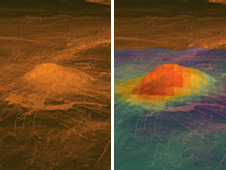Does Venus have Active Volcanoes?

Artistic impression of an active volcano on Venus.
Copyright ESA/AOES
Copyright ESA/AOES
Beautiful Venus, jewel of the skies, the evening star, is the closest place to hell in our Solar System. It’s atmospheric pressure crushes down with immense force, equivalent to a depth of 900 meters below our ocean’s surface – enough to kill a nuclear submarine. The atmospheric temperature is hot enough to melt lead. It rains sulphuric acid. And as if that weren’t enough, new data from the European Space Agency’s (ESA) Venus Express orbiter suggest that it might have active volcanoes as well.
Venus Explorer has been orbiting the planet since 2006, monitoring its atmosphere with an array of sophisticated instruments. Several years ago, it found evidence that Venus is geologically active, in the form of volcanoes which must have formed within the past few million years (practically yesterday, in geological terms), but it wasn’t clear whether those volcanoes were still active. But six years of atmospheric data have revealed large changes in the sulphur dioxide content of Venus’s atmosphere, and active vulcanism seems to be a likely cause.
Venus is a lot closer to the Sun than Earth, so it gets a lot more sunlight, which breaks down sulphur dioxide. This means that there is no SO2 in the upper layers of the atmosphere; it is only found below the upper cloud decks. Even this lower-level SO2 can’t hang around for long, as it gradually mixes upwards, so something must be going on to keep replenishing the supply. Whatever it is, it seems to come in spurts as the data returned from Venus Express (and NASA’s earlier Pioneer Venus mission) show that the levels of SO2 change rapidly over short times. Immediately after arriving at Venus in 2006, the spacecraft recorded a significant increase in the average density of sulphur dioxide in the upper atmosphere, followed by a sharp decrease. The levels today are only a tenth of those initial measurements. Pioneer Venus recorded a similar pattern during its mission when it orbited the planet from 1978 to 1992.
Trying to figure out exactly where the gas comes from is made difficult by the nature of Venus’s atmosphere: Although the planet has incredibly long days (it takes 243 Earth days to rotate just once about its axis), the atmosphere itself whips around in only 4 days, meaning it’s average speed at the equator is close to 400km/h. Any volume of SO2 that’s released into the atmosphere spreads out away from its source very quickly.
On the other hand, the scientists studying this problem are also considering that the variations we’re seeing might just be caused by the turbulent atmosphere concentrating and then dissipating the gas in a long-term natural cycle. “If you see a sulphur dioxide increase in the upper atmosphere, you know that something has brought it up recently, because individual molecules are destroyed there by sunlight after just a couple of days,” says Dr Emmanuel Marcq of Laboratoire Atmosphères, Milieux, Observations Spatiales, France, and lead author of the paper published in Nature Geoscience.
“A volcanic eruption could act like a piston to blast sulphur dioxide up to these levels, but peculiarities in the circulation of the planet that we don’t yet fully understand could also mix the gas to reproduce the same result,” adds co-author Dr Jean-Loup Bertaux, Principal Investigator for the instrument on Venus Express that made the detections.
“A volcanic eruption could act like a piston to blast sulphur dioxide up to these levels, but peculiarities in the circulation of the planet that we don’t yet fully understand could also mix the gas to reproduce the same result,” adds co-author Dr Jean-Loup Bertaux, Principal Investigator for the instrument on Venus Express that made the detections.
“Alternatively, and taking into account the similar trend observed by Pioneer Venus, it’s possible that we are seeing decadal-scale variability in the circulation of the atmosphere, which is turning out to be even more complex than we could ever have imagined,” Dr Marcq notes.
“By following clues left by trace gases in the atmosphere, we are uncovering the way Venus works, which could point us to the smoking gun of active volcanism,” adds Håkan Svedhem, ESA’s Project Scientist for Venus Express.
“By following clues left by trace gases in the atmosphere, we are uncovering the way Venus works, which could point us to the smoking gun of active volcanism,” adds Håkan Svedhem, ESA’s Project Scientist for Venus Express.
